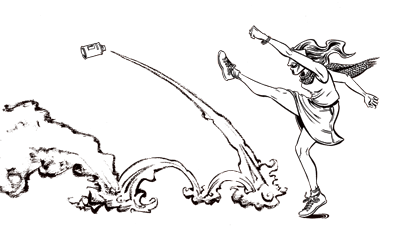I’ve been thinking a lot lately about the broad appeal that “punk” characters seem to have in comics. I already knew that, on the face of it, my writing a story about a garage band full of pissy youngsters was not unique. But I’ve only just become aware of how extremely non-unique it is. Just to take two examples from comics by cartoonists I have met since living in Portland in March:
Patrick Devine, who works down at the IPRC, gave me a copy of his zine “Calico Jack,” which mixes punk ethics/aesthetics with dilapidated spaceships in a way that calls to mind the subject matter of Jaime Hernandez’s “Love & Rockets” series, except that in my case I read “Calico Jack” first.
Steve Fuson, a regular contributor, with me, to Stumptown Underground, has a little series called “the Nihilist Club” whose assaholic skateboarding “protagonist” really takes the “hero” out of “anti-hero.” Reading it gave me a little shock, both because Steve is himself a very genteel person, and because his auto-bio webcomic, “Me&Ering,” is about as tame as that genre can be.
So why do so many comics artists feel drawn to this material? Is it because, as lonely losers who spend the best years of our lives hunched over a desk drawing imaginary picture stories, we idealize the opposite lifestyle of undisciplined mayhem and direct political engagement? Because we are boring milquetoasts who rebel vicariously through kick-ass rock stars and impossibly cute manic pixie dreamgirls? Because, impotent onanists that we are, we can only soothe our whimpering civic consciences by dressing up our flat solipsism in virtuous black leather and valiant mohawks?
Don’t answer that!
Obviously, there’s a very strong “indy” comics heritage informing most of us, one that has traditionally focused on marginal social groups (though usually not too marginal). What better suits the “warts and all” approach of these comics than the ugly truths of the underground music scene? There’s a lot of philosophical overlap between comics and rock, and you could write a whole book on the parallels between, and interconnectedness of, the two worlds.
But the mere fact that spiked collars and electric guitars are a comics cliche (and they definitely are) doesn’t negate their artistic potential. Heck, we’ve been churning out hundreds of comics a year about superheros for the past seven decades! And I’m not even going to dwell on the similarly hallowed legacies of TV shows about cops and lawyers, novels about writers who can’t write and painters who can’t paint, or songs about how, like, totally in love I am. These things are popular for a reason!
I think rebellion movements are interesting, not just entertaining, and I can’t overstate that the righteous anger of youth is very important, as well as, on occasion, pathetically hilarious. It’s pretty apparent by now that something in us needs to read about the hero punching out the villain. I think it’s equally true that we need to read about the teenager screaming at the cop.






